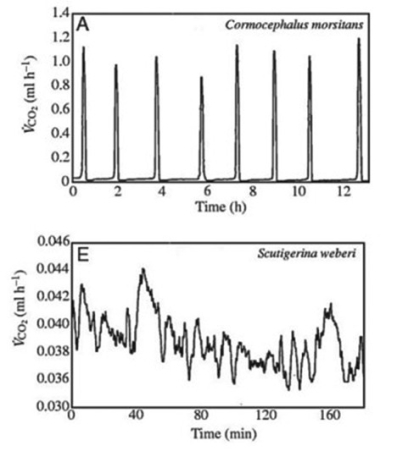Multiple Choice
Many terrestrial arthropods exchange gases with their environments by using tracheae, tubes that lead from openings (called spiracles) in the animal's exoskeleton or cuticle directly to the animal's tissues. Some arthropods can control whether their spiracles are opened or closed; opening the spiracles allows the carbon dioxide produced in the tissues to travel down the tracheae and be released outside the animal. Klok et al. measured the carbon dioxide emitted over time (represented by VCO₂) by several species of centipedes. The figures present graphs of their results for two species, Cormocephalus morsitans and Scutigerina weberi. (C. J. Klok, R. D. Mercer, and S. L. Chown. 2002. Discontinuous gas-exchange in centipedes and its convergent evolution in tracheated arthropods. Journal of Experimental Biology 205:1019-29.) Copyright 2002 The Company of Biologists and the Journal of Experimental Biology. 
Compare the graphs in the figure of carbon dioxide (CO₂) emission for Cormocephalus morsitans and Scutigerina weberi.
-What hypothesis can you make about each centipede's habitat?
A) C. morsitans lives in a habitat that provides more carbon dioxide than does S. weberi.
B) C. morsitans lives in a habitat with more predators than does S. weberi.
C) C. morsitans lives in a colder habitat than does S. weberi.
D) C. morsitans lives in a drier habitat than does S. weberi.
Correct Answer:

Verified
Correct Answer:
Verified
Q8: Compared to insects with incomplete metamorphosis, insects
Q19: The sea slug Pteraeolidia ianthina can harbour
Q20: Large animals need specialised organs for gas
Q25: A primary school science teacher decided to
Q26: The nontaxonomic term sea slug encompasses a
Q29: The sea slug Pteraeolidia ianthina can harbour
Q33: Which of the following animal groups is
Q36: Against which hard structure do the circular
Q73: Parasitism is one of the most widespread
Q81: A terrestrial animal species is discovered with